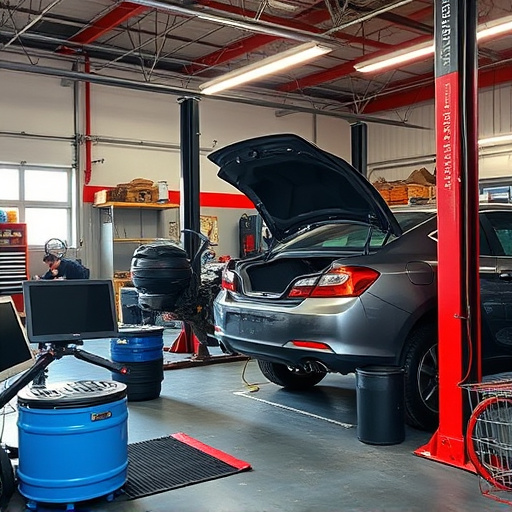When to Upgrade: New Auto Body Panels vs Repairs

When extensive damage or structural compromise occurs, replacing with new auto body panels is often…….
In the ever-evolving automotive landscape, the introduction of new auto body panels represents a significant stride towards safer, more efficient, and aesthetically pleasing vehicles. This cutting-edge technology is reshaping not just how cars are designed but also their performance and environmental impact. The article delves into the intricacies of new auto body panels, exploring their definition, global reach, economic implications, technological innovations, regulatory framework, challenges, and promising future prospects. By the end, readers will gain a comprehensive understanding of this transformative automotive trend and its potential to redefine the way we interact with vehicles.
Definition:
New auto body panels refer to advanced composite materials and engineering techniques used to construct exterior vehicle components, primarily body panels such as doors, fenders, hoods, and trunks. These panels are designed to replace traditional metal (often steel) body parts, offering enhanced performance in terms of strength, lightweight construction, durability, and crashworthiness.
Core Components:
Historical Context:
The concept of composite materials in automotive applications dates back to the 1960s, but their widespread adoption has accelerated in recent years due to stringent safety regulations, rising material costs, and environmental concerns. The shift towards lightweight materials is a response to global efforts to reduce vehicle weight, improve fuel efficiency, and lower carbon emissions.
Significance:
New auto body panels offer numerous advantages over traditional metal bodies:
The global market for new auto body panels is experiencing rapid growth, driven by the increasing adoption of electric vehicles (EVs) and stringent environmental regulations worldwide.
Regional Analysis:
Trends Shaping the Market:
The economic implications of new auto body panels are multifaceted, impacting both the automotive industry and global material supply chains.
Market Dynamics:
Investment Patterns:
Economic Impact:
The field of new auto body panels is characterized by rapid technological progress, pushing the boundaries of what’s possible in automotive design and performance.
Key Innovations:
Impact on Performance:
Future Potential:
The development and adoption of new auto body panels are influenced by various policies and regulations that ensure safety, environmental protection, and fair competition in the automotive industry.
Key Regulatory Frameworks:
Impact on Industry Development:
Despite its numerous advantages, the widespread adoption of new auto body panels is not without challenges and criticisms. Addressing these issues is crucial for the sustainable growth of this technology.
Main Challenges:
Criticisms and Solutions:
Real-world implementations of new auto body panels offer valuable insights into their practical applications, performance, and economic benefits.
Case Study 1: Tesla Model S
Tesla’s flagship Model S sedan showcases advanced composite technology in its sleek design and lightweight construction. The vehicle’s exterior is primarily composed of carbon fiber reinforced plastic (CFRP), contributing to its impressive range, acceleration, and aerodynamic efficiency. This application demonstrates the success of composite materials in premium electric vehicles.
Case Study 2: Toyota Prius
The iconic Toyota Prius has been using composite materials for years, notably in its hood and doors. These panels are made from a unique blend of polypropylene and fiber, offering lightweight solutions without compromising structural integrity. The Prius’s success highlights the versatility of composites in mass-market vehicles.
Case Study 3: Airbus A350 XWB
While not an automotive application, the Airbus A350 aircraft demonstrates the power of composite materials in aerospace. Its body is primarily constructed using carbon fiber composites, resulting in a significant weight reduction compared to traditional aluminum designs. This success story inspires confidence in composite technology’s potential across industries.
The future of new auto body panels looks promising, with emerging trends shaping the industry’s direction and strategic considerations guiding its growth.
Potential Growth Areas:
Emerging Trends:
Strategic Considerations:
New auto body panels represent a paradigm shift in automotive design and performance, offering a compelling path towards safer, more efficient, and environmentally conscious vehicles. The global impact of this technology is evident across regions, driven by stringent regulations, growing environmental concerns, and the push for lightweighting in vehicles. As the industry navigates challenges and embraces emerging trends, new auto body panels are poised to play an increasingly pivotal role in shaping the future of transportation.
Q: Are composite materials safe in case of a collision?
A: Advanced composite materials designed for automotive applications are engineered to absorb and distribute crash energy effectively, providing better protection for occupants compared to traditional metal bodies. Rigorous crash testing ensures their safety performance meets or exceeds regulatory standards.
Q: How do new auto body panels impact vehicle maintenance?
A: Composite materials generally require less maintenance than metallic bodies due to their superior corrosion resistance. They are also less prone to denting and scratching, reducing the need for frequent repairs and painting.
Q: Can composite materials be recycled?
A: While recycling composite materials is more complex than that of traditional metals, significant progress has been made. Researchers are developing efficient recycling processes, and some manufacturers are exploring closed-loop recycling systems to minimize environmental impact.
Q: Are composites more expensive than metal for vehicle bodies?
A: Initial costs for composite materials can be higher, but long-term savings from reduced weight, improved performance, and lower maintenance expenses often outweigh the initial investment. As production scales up, cost disparities may narrow.
Q: How do new auto body panels contribute to fuel efficiency?
A: By significantly reducing vehicle weight, composites enable automakers to meet stringent fuel economy standards while improving handling and reducing carbon emissions. This is particularly crucial for electric vehicles, where every gram counts in optimizing range and performance.

When extensive damage or structural compromise occurs, replacing with new auto body panels is often…….

New auto body panels, made from durable materials like steel, aluminum, and composite fibers, offer…….

The evolution of new auto body panels is driven by materials science advancements like composite fib…….

The cost of new auto body panels varies by vehicle make/model, panel rarity, and damage extent. Labo…….

Research vehicle specifications (make, model, year, trim, paint type/color code) to ensure accurate…….

New auto body panels are crucial for vehicle safety and aesthetics. Choose materials like steel or a…….

Choosing high-quality materials for new auto body panels is essential for top-notch repairs. Quality…….

Damaged exterior panels of a vehicle require replacement to maintain aesthetics and safety. New auto…….

Using new auto body panels adhering to factory specifications is crucial for high-quality vehicle re…….

When replacing new auto body panels, precise installation requires understanding unique vehicle dime…….